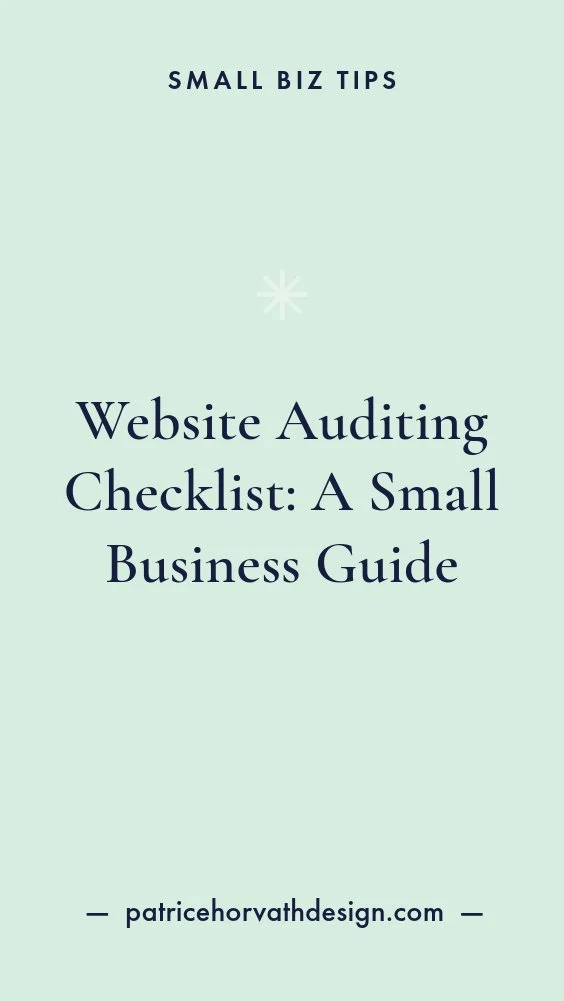Website Auditing Checklist: A Small Business Guide
A well-optimized website is essential for small businesses looking to attract clients and grow online. Whether you're using a Squarespace website or another platform, auditing your site ensures it's functional, user-friendly, and search-engine optimized. This guide will walk you through a comprehensive website auditing checklist to help you improve performance, usability, and SEO. Plus, download our free website auditing checklist to stay on track!
What is a Complete Website Audit?
A website audit process is a comprehensive analysis of your site’s performance, design, content, and SEO. Regular audits help small business owners identify issues that may impact visibility, user experience, and conversions and help improve your website. Conducting a detailed audit ensures that your website remains competitive and meets user expectations.
Why is a Website Audit Important?
Improve Website User Experience: A fast, intuitive, and well-structured site keeps visitors engaged.
Enhances SEO Performance: Search engines favor optimized, high-quality websites.
Boosts Conversion Rates: A streamlined, user-friendly site encourages visitors to take action.
Ensures Mobile Compatibility: With most users browsing on mobile devices, mobile responsiveness is critical.
Identifies Security Issues: Regular audits help detect vulnerabilities and keep your site secure.
Step-by-Step Website Auditing Checklist
1. Technical Audit
Check Website Speed: Use tools like Google PageSpeed Insights to analyze load times.
Ensure Mobile-Friendliness: Your site should be responsive and display well on all devices.
Fix Broken Links: Scan for and repair broken internal and external links.
Secure Your Site: Confirm that your website uses HTTPS for security.
Review Hosting & SSL Certificate: Ensure your hosting plan supports fast loading speeds and that your SSL certificate is active. Squarespace provides free ssl.
2. Design & User Experience Audit
Optimize Navigation & Structure: Ensure a clear, intuitive menu with easy access to key pages of your website.
Maintain Brand Consistency: Review fonts, colors, and imagery for a cohesive look.
Enhance Call-to-Actions (CTAs): Check that CTAs are clear, engaging, and strategically placed.
Ensure Accessibility Compliance: Implement alt text for images, readable fonts, and proper color contrast.
Review Contact & About Pages: These critical pages should be easy to find and informative.
3. Content Audit
Optimize SEO-Friendly Titles & Headings: Use keywords naturally in page titles, headers, and meta descriptions.
Improve Readability: Ensure your content is engaging, scannable, and free of errors.
Update Information: Remove outdated details, broken images, or incorrect pricing.
Analyze Blog Performance: Review blog posts for relevance, engagement, and keyword usage.
Optimize Multimedia: Compress images and videos for faster loading speeds.
4. Free SEO Audit Checklist & Website Performance Audit
Implement Keyword Optimization: Ensure your content includes relevant keywords naturally.
Enhance Meta Descriptions & Alt Text: Optimize meta descriptions and image alt text for on-page SEO to improve search results.
Review Internal Links & External Links: Use quality link-building strategies to improve navigation and credibility and reduce technical SEO issues.
Monitor with Google Search Console & Analytics: Use these tools to track performance and identify areas for improvement.
5. Squarespace-Specific Site Audit
Check Page Layout & Blocks: Ensure proper use of Squarespace blocks for a streamlined design, especially ensure that the website is optimized on both desktop and mobile devices.
Review Technical SEO Audit Settings: Optimize Squarespace’s built-in SEO settings for each page.
Test Forms & Integrations: Confirm all forms and third-party integrations function correctly.
Ensure Social Media Integration: Verify that social links are functional and properly displayed.
6. Optimize with SEOspace*
If you're looking for an easy way to improve your Squarespace SEO, I highly recommend SEOspace*. This tool provides step-by-step instructions to optimize your website, making it simple to improve rankings and visibility. It’s especially useful for small business owners who want to handle SEO without hiring a specialist.
Check out SEOspace here and start optimizing your Squarespace website today!
Free Website Auditing Checklist
To make your audit easier, grab our free website auditing checklist PDF. This resource free tool will help you stay on track and implement the best practices outlined in this guide.
FAQ Section
What should be included in a technical website audit?
A website audit tool should analyze speed, SEO, usability, security, content quality, and design.
How do I audit website content?
Review content for accuracy, readability, keyword optimization, and overall engagement.
How do I perform a website audit manually?
Manually auditing your website involves checking page speed, mobile-friendliness, SEO, and user experience using tools like Google Analytics and PageSpeed Insights.
How do I conduct a website audit in 6 simple steps?
Start with a technical check.
Review your website design.
Analyze content quality.
Optimize SEO settings.
Check performance metrics.
Fix identified issues in priority order.
How often should I audit my website?
Ideally, you should perform a full website audit every six months to keep your site optimized and competitive.
Can I audit my website myself?
Yes! Many small business owners perform DIY audits using SEO software tools like Google Search Console, SEOspace*, and Squarespace’s built-in SEO features. However, a professional audit may provide deeper insights and technical improvements.
Next Steps
A website audit is a powerful tool to enhance areas of your website your site’s performance, user experience, and SEO. Regularly reviewing and updating your website ensures long-term success. If you need professional help, a Squarespace designer can assist in optimizing your site for better results.
*Affiliate Disclosure: This post contains affiliate links, meaning I may earn a commission if you purchase through these links, at no additional cost to you. I only recommend products or services I personally use and trust.

